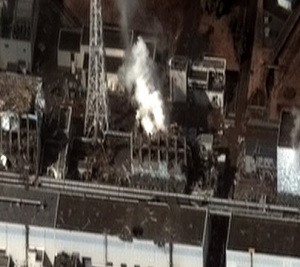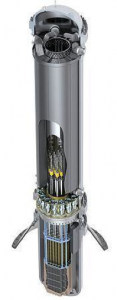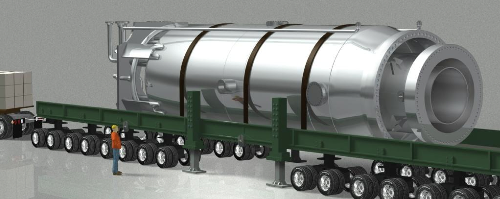The sudden Fukushima nuclear catastrophe has had an enormous impact on the global nuclear industry. Japan's continuing human, environmental, and economic disaster appeared to cause the touted 2011 US nuclear renaissance, backed by loan guarantees from the Obama Administration, to grind to a halt. And then watching Germany, followed by Switzerland, vow to switch to renewables, the future for US nuclear energy looked pretty dark--turn the lights off on the way out, so to speak.

A contrarian nuclear future
Now, a newly released study from the Energy Policy Institute at the University of Chicago finds that small modular reactors (SMR) may hold the key to an actual renaissance of U.S. nuclear power (read whole study):
"Clearly, a robust commercial SMR industry is highly advantageous to many sectors in the United States," concluded the study, led by Robert Rosner, director of the Energy Policy Institute at the University of Chicago.
Through his work as the former director of Argonne National Laboratory, Rosner became involved in nuclear and renewable energy technology development.
"It would be a huge stimulus for high-value job growth, restore U.S. leadership in nuclear reactor technology and, most importantly, strengthen U.S. leadership in a post-Fukushima world, on matters of nuclear safety, nuclear security, nonproliferation, and nuclear waste."
This represents a huge shift from last century's large-reactor build-out, which eventually petered out and stagnated. Before construction stopped, new reactors had grown larger and larger as utilities tried to reduce costs through economies of scale. But now the trend may be toward what SMR proponents call economies of "small scale." Creating value through standardized, mass produced, small modular reactors. Energy Secretary Steven Chu agrees (video above).
Voting with their balance sheets
This trend had already begun before the Fukushima disaster. A couple of salient examples from 2010: rising reactor costs had already created friction between partners CPS Energy and NRG Energy Inc., who had sued each other when CPS, a city-owned utility in San Antonio balked about investing in a new nuclear plant that would raise customer's rates. Then, as if the industry's "nuclear renaissance" wasn't already gasping for air, it swooned into a coma after the collapse of Constellation Energy's plan to build a third reactor on Maryland's Chesapeake Bay with French utility EDF.

But while those large reactor projects were falling apart, the small modular reactor trend was beginning to take shape. The Texas-sized Fluor Corporation, which had built large reactors in the 70s and 80s, spent $3.5 million for the majority stake in small module reactor builder NuScale. Then Bechtel, another engineering giant, formed an alliance with Babcock & Wilcox, buying into its innovative modular nuclear technology called mPower. Both investments were big votes of confidence.
Comparing large and small reactors
The SMR report, funded by the DOE and authored by Rosner and Stephen Goldberg, was rolled out on Dec. 1, at the Center for Strategic and International Studies. CSIS president and CEO John Hamre started off the press conference by reconfirming that economic issues have hindered the construction of new large-scale reactors in the United States. You can watch the long version of the press conference video below:
The chief competitor
The report assessed the economic feasibility of classical, gigawatt-scale reactors and the possible new generation of modular reactors. The latter would have a generating capacity of 600 megawatts or less, would be factory-built as modular components, and then shipped to their desired location for assembly. According to the study, few companies can afford the long wait to see a return on a $10 billion investment on a large-scale nuclear plant. This is a real problem, but the epoch of the small modular reactor offers the promise of factory construction efficiencies with a much shorter timeline. The report also finds that natural gas will be the chief competitor of nuclear power generated by small modular reactors, but predicting the future of the energy market a decade from now is a risky proposition, (implying that prices could easily go higher) Rosner said. "We're talking about natural-gas prices not today but 10, 15 years from now when these kinds of reactors could actually hit the market."
Markets that can't use gigawatt-scale plants
The economic viability of small modular reactors will depend partly on how quickly manufacturers can learn to build them. "The faster you learn, the better off you are in the long term because you get to the point where you actually start making money faster," Rosner noted. Of course, this assumes that SMRs are all factory built and delivered to the reactor site by rail or truck. Then on-site construction would never be able to compete.

Small modular reactors would appeal to any market that couldn't accommodate gigawatt-scale plants (particularly developing countries with smaller or older grids), or those in the US currently served by aging, 200- to 400-megawatt coal plants, which are likely to be phased out during the next decade, Rosner said. An unknown factor that will affect the future of these plants would be the terms of any new clean-air regulations that might be enacted in the next year. An important safety aspect of small modular reactors is that they are designed to eliminate the need for human intervention during an emergency. In some of the designs, Rosner explained, "the entire heat load at full power can be carried passively by thermal convection. There's no need for pumps." Getting the first modular reactors built will probably require the federal government to step in as the first customer. That is a policy issue, though, that awaits further consideration. "It's a case that has to be argued out and thought carefully about," Rosner said. "There's a long distance between what we're doing right now and actually implementing national policy."


